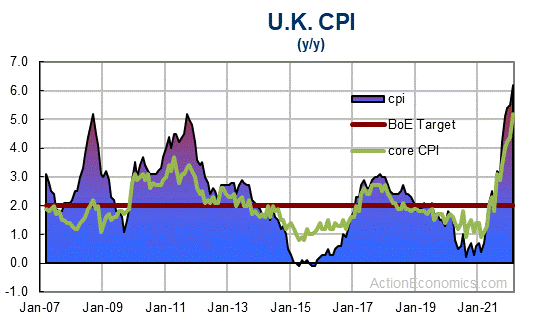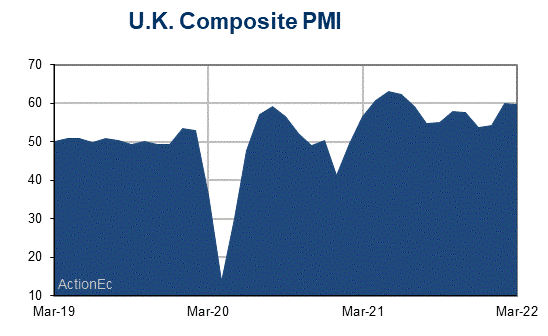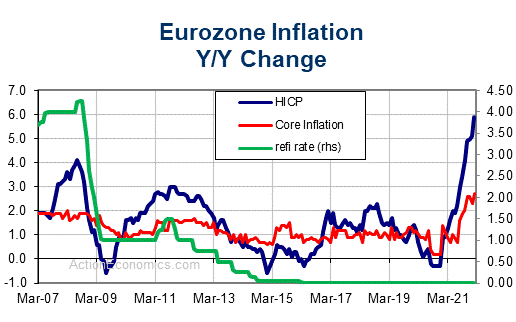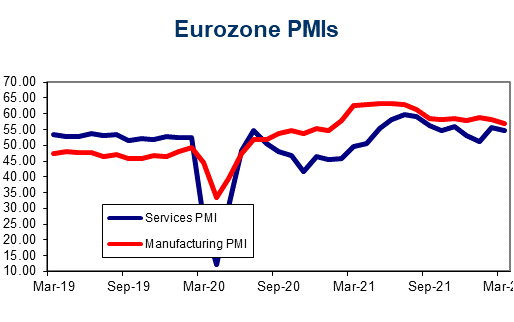The FOMC announcement is out of the way, and the fact that the US central bank has not only prepared the ground for a lift off in rates, but also flagged that a balance sheet reduction is coming into view, has boosted speculation for further action from the BoE next week. It seems that if the Fed is confident enough on the recovery to map out the way to a removal of policy accommodation, the BoE can also afford to focus on inflation risks and overlook remaining uncertainties. There is also some movement at the ECB it seems, and pressure to at least commit to an end date for net asset purchases is mounting as German data signals a quick recovery from Omicron.

The BoE already lifted the Bank Rate by 15 bp to 0.25% in December, and after yesterday’s Fed announcement, markets are preparing for further action next Thursday, when the MPC once again sets policy. The 2-year rate jumped 0.99% early in the session (the highest rate since 2011) before the paper found buyers, but it is clear that there was a general repricing of UK tightening risks this morning, prompted by the FOMC’s message that effectively endorsed a rate hike in March with more to come in later months.
The fact that the BoE hasn’t pushed back against lingering speculation of another move next week has only added to pressure on bonds since hot inflation and labour market data was released.
CPI inflation hit 5.4% in December and if that doesn’t look high enough, the debate on different inflation measures and the different impacts of looming energy price hikes on different income brackets has fueled the debate on adequate wage demands. RPI is no longer an officially recognised measure, but still used by unions and that number hit a whopping 7.7% at the end of last year. At the same time the Institute for Fiscal Studies think tank has warned that if energy prices and other essential items rise as expected, lower income groups would face price hikes nearly 1.5% points higher than richer households, due to the larger share of their income that is eaten up by these items.
 The latest growth numbers meanwhile have looked mixed, with PMI reports disappointing and monthly GDP looking lacklustre even ahead of Omicron restrictions. Still, with labour market data pointing to ongoing tightening, cost pressures and staff shortages, unions have been given a very strong hand in wage talks this year. So more rate hikes clearly are on the way and while there may be arguments for the BoE to wait another month, it seems unlikely that officials wouldn’t have pushed back against mounting market speculation of a follow up move next week.
The latest growth numbers meanwhile have looked mixed, with PMI reports disappointing and monthly GDP looking lacklustre even ahead of Omicron restrictions. Still, with labour market data pointing to ongoing tightening, cost pressures and staff shortages, unions have been given a very strong hand in wage talks this year. So more rate hikes clearly are on the way and while there may be arguments for the BoE to wait another month, it seems unlikely that officials wouldn’t have pushed back against mounting market speculation of a follow up move next week.
The BoE last delivered back to back hikes in 2014 and another move higher in Bank Rate would also open the way to a scaled back balance sheet, via an end to the re-investment of expired bonds, starting with GBP 28 bln of Gilts maturing in March. What could still throw a spanner in the works are escalating tensions with Russia over the Ukraine, which indirectly also impacts energy supplies, and of course the developing situation in Westminster, where PM Johnson is still fighting Partygate and calls for him to resign. And with the markets pretty much pricing in a move, the event risk is not so much that the BoE is hawkish, but that the BoE fails to deliver, which could see Gilts rallying and the Pound selling off in the initial reaction.

Over in Frankfurt meanwhile the ECB remains much more generous, but most recent comments also suggest an ongoing shift. The December forecasts still saw inflation slightly below the 2% mark this year on average this year and next. Chief economist Lane now says it is possible that inflation will stabilise around the 2% mark. The main tenor of the arguments has switched from stressing that generous policies remain necessary to bring inflation to target in the medium run, to saying that inflation won’t overshoot the target to an extent that would require significant tightening. That is quite a change that is likely to be reflected in the ECB’s statement next week.
So far the ECB’s main scenario has been that rates will remain on hold through this year with the guidance that net asset purchases would end shortly before the first rate hike.
When they will end remains open so far and while net asset purchases via the APP program are set to run at a higher pace through the second and third quarter, when PEPP has ended, there is no commitment to let net purchases run through the fourth quarter. In theory then the first step for the ECB would be to commit to an end date for net asset purchases under the APP program. That could happen next week, if the ECB is ready to accept that interest rates could rise earlier than previously anticipated in the light of rising inflation pressures.

The growth outlook clearly plays a major role and the ECB next week will also have advance Q4 GDP readings as well as the full round of January confidence numbers. Q4 numbers won’t look stellar, largely thanks to Omicron and the renewed hit to the services sector. However, survey data suggests not just that supply chain disruptions are easing, but also that the services sector will be bouncing back relatively quickly from Omicron. Germany, which is set to report a negative quarterly GDP rate for Q4, has seen a round of much stronger than expected survey readings at the start of the year. PMI and Ifo reports suggested a turnaround, and today’s consumer confidence number also improved unexpectedly.
Clearly downside risks remain, and Germany in particular will feel the chill from slowing growth in China. However, if the Fed is sufficiently confident on the growth outlook to map out a path to removing stimulus, the ECB will risk falling behind the curve if it doesn’t at least confirm an end date for net asset purchases. Trying to keep all sides happy, which seems to be Lagarde’s preferred course of action, may no longer work and could end up being counter-productive if the central bank’s credibility is lastingly undermined.
Click here to access our Economic Calendar
Andria Pichidi
Market Analyst
Disclaimer: This material is provided as a general marketing communication for information purposes only and does not constitute an independent investment research. Nothing in this communication contains, or should be considered as containing, an investment advice or an investment recommendation or a solicitation for the purpose of buying or selling of any financial instrument. All information provided is gathered from reputable sources and any information containing an indication of past performance is not a guarantee or reliable indicator of future performance. Users acknowledge that any investment in Leveraged Products is characterized by a certain degree of uncertainty and that any investment of this nature involves a high level of risk for which the users are solely responsible and liable. We assume no liability for any loss arising from any investment made based on the information provided in this communication. This communication must not be reproduced or further distributed without our written permission.



















